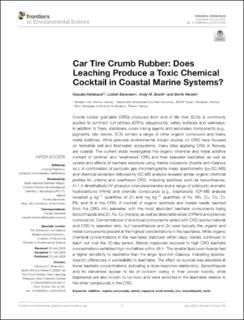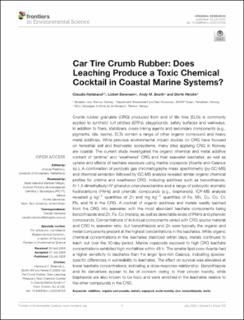| dc.description.abstract | Crumb rubber granulate (CRG) produced from end of life tires (ELTs) is commonly applied to synthetic turf pitches (STPs), playgrounds, safety surfaces and walkways. In addition to fillers, stabilizers, cross-linking agents and secondary components (e.g., pigments, oils, resins), ELTs contain a range of other organic compound and heavy metal additives. While previous environmental impact studies on CRG have focused on terrestrial soil and freshwater ecosystems, many sites applying CRG in Norway are coastal. The current study investigated the organic chemical and metal additive content of ‘pristine’ and ‘weathered’ CRG and their seawater leachates, as well as uptake and effects of leachate exposure using marine copepods (Acartia and Calanus sp.). A combination of pyrolysis gas chromatography mass spectrometry (py-GC-MS) and chemical extraction followed by GC-MS analysis revealed similar organic chemical profiles for pristine and weathered CRG, including additives such as benzothiazole, N-1,3-dimethylbutyl-N′-phenyl-p-phenylenediamine and a range of polycyclic aromatic hydrocarbons (PAHs) and phenolic compounds (e.g., bisphenols). ICP-MS analysis revealed g kg–1 quantities of Zn and mg kg–1 quantities of Fe, Mn, Cu, Co, Cr, Pb, and Ni in the CRG. A cocktail of organic additives and metals readily leached from the CRG into seawater, with the most abundant leachate components being benzothiazole and Zn, Fe, Co (metals), as well as detectable levels of PAHs and phenolic compounds. Concentrations of individual components varied with CRG source material and CRG to seawater ratio, but benzothiazole and Zn were typically the organic and metal components present at the highest concentrations in the leachates. While organic chemical concentrations in the leachates stabilized within days, metals continued to leach out over the 30-day period. Marine copepods exposed to high CRG leachate concentrations exhibited high mortalities within 48 h. The smaller lipid-poor Acartia had a higher sensitivity to leachates than the larger lipid-rich Calanus, indicating species-specific differences in vulnerability to leachates. The effect on survival was alleviated at lower leachate concentrations, indicating a dose-response relationship. Benzothiazole and its derivatives appear to be of concern owing to their proven toxicity, while bisphenols are also known to be toxic and were enriched in the leachates relative to the other compounds in the CRG. | en_US |


